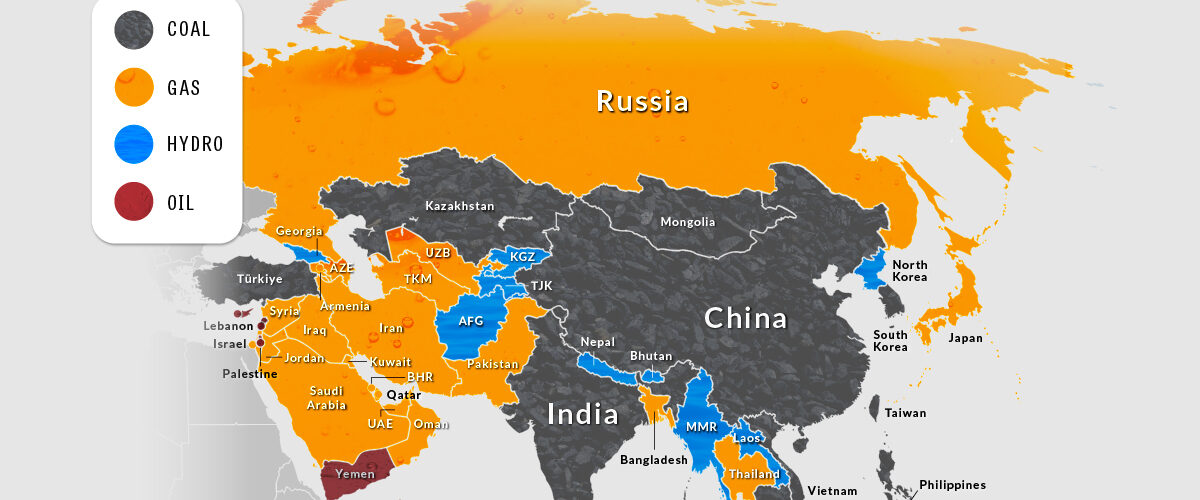Mapped: Asia’s Biggest Sources of Electricity by Country
This was originally posted on Elements. Sign up to the free mailing list to get beautiful visualizations on natural resource megatrends in your email every week.
The International Energy Agency (IEA) predicts that Asia will account for half of the world’s electricity consumption by 2025, with one-third of global electricity being consumed in China.
To explore how this growing electricity demand is currently being met, the above graphic maps out Asia’s main sources of electricity by country, using data from the BP Statistical Review of World Energy and the IEA.
A Coal-Heavy Electricity Mix
Although clean energy has been picking up pace in Asia, coal currently makes up more than half of the continent’s electricity generation.
No Asian countries rely on wind, solar, or nuclear energy as their primary source of electricity, despite the combined share of these sources doubling over the last decade.
| % of total electricity mix, 2011 | % of total electricity mix, 2021 | |
|---|---|---|
| Coal | 55% | 52% |
| Natural Gas | 19% | 17% |
| Hydro | 12% | 14% |
| Nuclear | 5% | 5% |
| Wind | 1% | 4% |
| Solar | 0% | 4% |
| Oil | 6% | 2% |
| Biomass | 1% | 2% |
| Total Electricity Generated | 9,780 terawatt-hours | 15,370 terawatt-hours |
The above comparison shows that the slight drops in the continent’s reliance on coal, natural gas, and oil in the last decade have been absorbed by wind, solar, and hydropower. The vast growth in total electricity generated, however, means that a lot more fossil fuels are being burned now (in absolute terms) than at the start of the last decade, despite their shares dropping.
Following coal, natural gas comes in second place as Asia’s most used electricity source, with most of this demand coming from the Middle East and Russia.
Zooming in: China’s Big Electricity Demand
While China accounted for just 5% of global electricity demand in 1990, it is en route to account for 33% by 2025. The country is already the largest electricity producer in the world by far, annually generating nearly double the electricity produced by the second largest electricity producer in the world, the United States.
With such a large demand, the current source of China’s electricity is worthy of consideration, as are its plans for its future electricity mix.
Currently, China is one of the 14 Asian countries that rely on coal as its primary source of electricity. In 2021, the country drew 62% of its electricity from coal, a total of 5,339 TWh of energy. To put that into perspective, this is approximately three times all of the electricity generated in India in the same year.
Following coal, the remainder of China’s electricity mix is as follows.
| Source | % of total electricity mix (China, 2021) |
|---|---|
| Coal | 62% |
| Hydropower | 15% |
| Wind | 8% |
| Nuclear | 5% |
| Solar | 4% |
| Natural Gas | 3% |
| Biomass | 2% |
Despite already growing by 1.5x in the last decade, China’s demand for electricity is still growing. Recent developments in the country’s clean energy infrastructure point to most of this growth being met by renewables.
China does also have ambitious plans in place for its clean energy transition beyond the next few years. These include increasing its solar capacity by 667% between 2025 and 2060, as well as having wind as its primary source of electricity by 2060.
Asia’s Road to Clean Energy
According to the IEA, the world reached a new all-time high in power generation-related emissions in 2022, primarily as a result of the growth in fossil-fuel-generated electricity in the Asia Pacific.
With that said, these emissions are set to plateau by 2025, with a lot of the global growth in renewables and nuclear power being seen in Asia.
Currently, nuclear power is of particular interest in the continent, especially with 2022’s energy crisis highlighting the need for energy independence and security. India, for instance, is set to have an 80% growth in its nuclear electricity generation in the next two years, with Japan, South Korea, and China following suit in increasing their nuclear capacity.
The road ahead also hints at other interesting insights, specifically when it comes to hydropower in Asia. With heatwaves and droughts becoming more and more commonplace as a result of climate change, the continent may be poised to learn some lessons from Europe’s record-low hydropower generation in 2022, diverting its time and resources to other forms of clean energy, like wind and solar.
Whatever the future holds, one thing is clear: with ambitious plans already underway, Asia’s electricity mix may look significantly different within the next few decades.
[ad_2]
Source link


